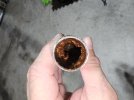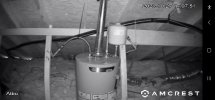the condensate pump fails for whatever reason
No pump here... just gravity... line is probably more likely to clog up since it doesn't get "flushed", but it seems ok.
the condensate pump fails for whatever reason
I'm more interested in all of those nails sticking out from the underside of the roof that are just holding onto thin air.I could not resist posting this.
View attachment 188258
yep, mice and insulation, plus wasps building nests in pipes... the usual causes. Even with gravity drain condensate lines, we're still required to have float kill switch on the drip pan, in case of clogged drain or failed condensate pump. Good idea. Seen the kill switches save home owner a LOT of repair work.No pump here... just gravity... line is probably more likely to clog up since it doesn't get "flushed", but it seems ok.
Even with gravity drain condensate lines, we're still required to have float kill switch on the drip pan, in case of clogged drain or failed condensate pump. Good idea.
I'm more interested in all of those nails sticking out from the underside of the roof that are just holding onto thin air.
There are different types. Some mount on side of the metal drip/overflow pan under the airhandler, others are part of an integral pan drain kit... but most I see are just a simple float switch that mounts to the side of the overflow pan under the air handler.. Here are some examples - Some switches have dual contacts, so one set can be used to shut off the HVAC system in event of overflow, and another set of contacts to activate an alarm system, indicators etcIt is a good idea... even if it's not required... I'm gonna take a look at mine next time I'm up there and see how I can add a float switch!
Me too, and a few dollars as well.funny... I've spent lots of time on that site before!
American roofing is weird.Nails from the shingles on top...
American roofing is weird.
Well Oldtechguy66, you were correct. I often go up to my attic (once a week or so) and check things out. Sure as shit, I saw a few small dried up water puddles on top of my water tank. F me. Started feeling around, sure enough, one of the galvanized pipe joints was leaking. Now using the term 'leaking' is really extreme. It was maybe a drop a day, IDK, but really, really minute. But sure as hell was enough to keep me from sleeping. Again, if it was in the garage, pfffft. But in my attic...nope. So I went to Home Depot and bought all brass piping and fittings. I also learned and LOVE Blue Monster pipe dope and Teflon tape. Screw that flimsy ass white crap. I was amazed when I took the pipes apart at how much RUST was in them already! Holy crap.....the rust. Glad I got to it before it damaged my water tank. After all was said and done, I decided to replace both of the inlet pipes as well, and yes, I used shark bite connections. Yes, yes, I know.....the haters hate and I understand that. But they have NEVER failed me....so I will go with them until one does. Anyways, was pretty happy with my setup until my friend (the housing inspector) told me she would recommend against shark bites. But she also has not witnessed one fail yet either, just her thing. So, with that said....I decided to put a camera on it. Ha, ha. Go figure. Got me another wireless Amcrest PTZ camera and hooked it up. Now I feel much more comfortable with it. Yeah its a mental game in my head, I know. Anyways, thought I would share. I only used one galvanized joiner for the expansion tank, and none of the metal inside is exposed to water so it should be OK.I'm in the NC mountains, so NO water lines of any kind in attics here! ... but I have seen them only an hour south of me in SC. NOT fun working in a broiler hot attic in summer.
One thing I've found over the years working in the southern US Appalachian mtns is avoid the use of galvanized pipe like the plague! Whether connecting H20 heaters, or especially around well pump switches and pressure tanks... it WILL accelerate corrosion in the rest of the plumbing wherever there is metal (galvanic reaction), and it occurs rapidly when the H2O pH is below 7 (neutral), and with iron present in the water (it builds plugs pipe fittings). Might get away with it on treated municipal H20, but here in the mtns, well water is usually acidic and has at least some iron. Spring fed sources are often even lower pH and high levels of dissolved iron. Galvanized pipe, even short sections or fittings, will cause problems here in short order. Also, I started using electronic anode rod (cathodic protection) because old style zinc and even aluminum anode rods rapidly degrade, often producing nasty amounts of H2S in the water. Electronic anodes are a bit pricey, but extend the life of the tank substantially in harsh water environments. Where we are, it's common to have extensive H20 filtration systems, & softeners. Don't neglect maintenance if you have them, else you'll be replacing that new H20 heater much sooner than planned. Also, don't forget to check your line pressure frequently, especially on municipal H2O systems. Here in the mtns, it's not uncommon to see city water supply pressure to residences hit 300+ psi at night. Your H20 heater cannot handle that for long. So, most codes require use of a PRV (pressure reducing valve) at the water line entrance to the residence. Our code also now mandates use of pressure relief valves to dump excess pressure in event (when, not if) the PRV fails (and the do fail).
So, got that new H2O heater installed.. but don't forget, there are other items to check in the supply chain. Those often neglected items are the ones usually repsonsible for water heater failures.
Just my 2 cents, YMMV...





